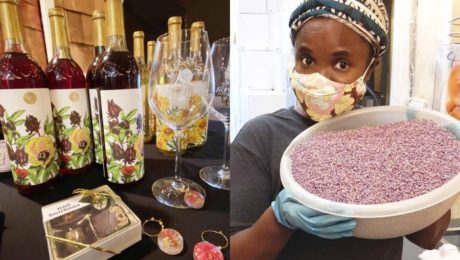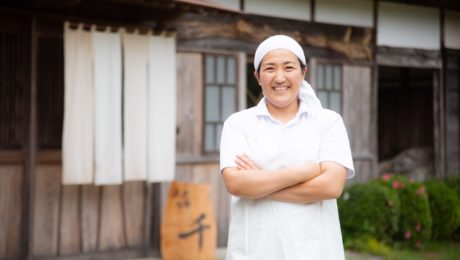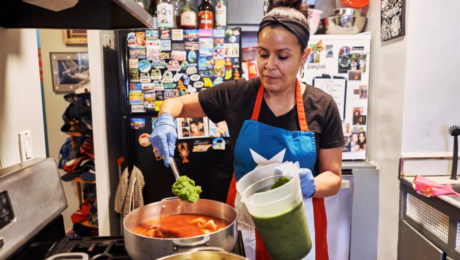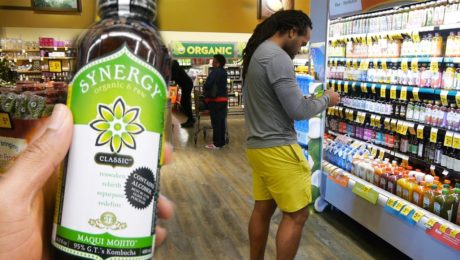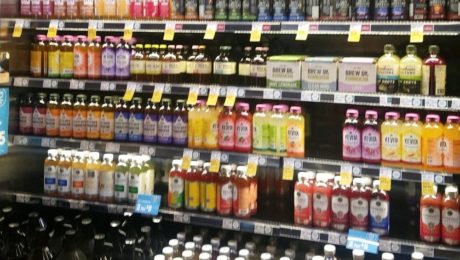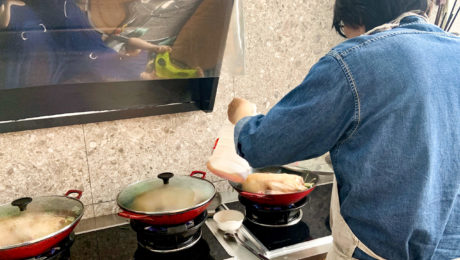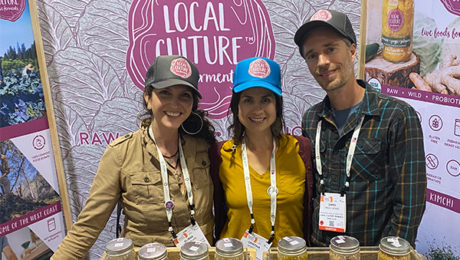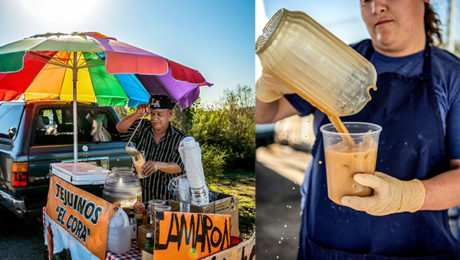An Overlooked Wine Category
“Aaliyah Nitoto, winemaker at Free Range Flower Winery, is tired of hearing that the category of wine is exclusive to grapes. For centuries, wine has been made from many kinds of plant products, she says, like grapes, apples, pears, rice and flowers,” reads an article in Wine Enthusiast.
The magazine highlights the history of flower wine, which has variations in the Middle East, Asia, Europe and even the U.S. The process to make the wine is different from a traditional grape wine. Fresh or dried flowers are boiled and crushed, then yeast and a sugar source are added to start the fermentation process.
Flower winemakers lament that their product is not respected in the wine industry. Flower wine has been made primarily by middle- to lower-income women.
“That can tell you right there why they were relegated to obscurity. The people who owned tracts of lands that had money and influence and got to name things like ‘noble grapes,’ they got to say what was wine and what wasn’t,” Nitoto (pictured) adds. “The opinion of people in this country over the last 100-odd years to try to get rid of this category doesn’t stand up to the history of winemaking, which is thousands of years old, which does call this wine.”
Read more (Wine Enthusiast)
- Published in Food & Flavor
Japanese Cheese
Using local microbes, sakura blossoms, sake and takesumi (bamboo charcoal), chef and microbiologist Chiyo Shibata wants to “introduce Japan through cheese.” She runs cheesery Fromage Sen in mountainous Chiba Prefecture east of Tokyo.
Shibata fell in love with cheese — not a part of a traditional Japanese diet — while visiting France as a child. She later studied microbiology and fermentation at Tokyo University, then apprenticed to cheesemakers in France. When she returned to Japan to work at a government food safety lab, cheesemaking became her side hobby. Asked to analyze the safety of dried fish maker Koshida Shouten’s 50-year-old brine, Shibata made an interesting discovery. Not only was it safe, but the brine was teaming with lactobacilli. Inspired by the world of microbes, Shibata used a sample of brine as the foundation for her Japanese cheese.
“These microbes are the way to realize the terroir unique to this place and convey the message that this is our own cheese,” she says. She opened her rural cheesery in 2014 and has since won multiple honors, including Japan Cheese and World Cheese awards. Her handcrafted cheese, made with local ingredients, is aged 2-4 weeks. “Each ingredient is good on its own, but when you bring them together, they draw out their strengths and become something even more beautiful.”
Interestingly, Eric C. Rath, a professor of Japanese history at the University of Kansas, says cheese was never traditional fare in Japan because grazing cows on the country’s rocky terrain is difficult. But ancient texts describe three things similar to cheese: so, raku and daigo. Daigo was described as “the epitome of dairy products. Buddhist monks compared its taste to enlightenment,” Rath said. It’s unknown how these dairy products were made.
Read more (Atlas Obscura)
- Published in Food & Flavor
Regulating Home Chefs
The loosely-regulated cottage food industry is growing, as home chefs find it easier than ever to sell handmade meals via online services like WoodSpoon and Shef. These companies are part of the gig economy and trust that chefs will apply for the proper state and local permits to sell food made in a home kitchen. But these apps do not police regulatory compliance, noting only 20-30% of their chefs are licensed.
“In recent months, states have loosened restrictions to make it easier for home cooks to sell products online, but the result is a patchwork of state and local rules, regulations and permit requirements,” reads an article in The New York Times. “Some states allow home cooks to sell only baked goods like bread, cookies or jellies. Others put caps on the amount of money home cooks can make. And other states require the use of licensed facilities, such as commercial kitchens.”
Adds Oren Saar, founder and the chief executive of WoodSpoon: “We are ahead of the regulators, but as long as I keep my customers safe and everything is healthy, there are no issues. We believe our home kitchens are safer than any restaurants.”
As the pandemic ebbs and Americans feel cooking burnout, companies are investing tens of billions into the changing food industry. Alt protein, fast food, food delivery, functional snacks and alt food are all facets of a food industry growing and changing post-pandemic. The New York Times says they’re all making “bets on what, where and how consumers will eat in the coming years.”
Read more (The New York Times)
- Published in Business, Food & Flavor
Kombucha Sales Crawl
Two years after kombucha sales began to clock double-digit growth during the pandemic, sales are slowing, increasing only 1% over the last 52 weeks. But kombucha is still the sales leader in the fermented, non-alcoholic beverage space, representing nearly 85% of the category.
Kombucha pioneered the refrigerated functional beverage industry. For years it was one of the few beverages in the fermented, non-alcohol beverage space. But now there’s competition from new functional drinks — like prebiotic- and probiotic-infused sodas — that are diverting sales from kombucha.
“The consumer really is not OK with just drinking water. They want functionality out of everything they consume,” says Caroline Davidson, director of channel partnerships at SPINS (a data provider for natural, organic and specialty products). “Non-alcoholic beverages are traditionally not healthy options. To see that kombucha is actually one of the few segments contributing to double-digit growth (in that category), it’s really refreshing and encouraging.”
Those numbers were presented at KombuchaKon, the conference and trade show produced by Kombucha Brewers International (KBI). The event had been virtual the last two years, and brewers were anxious to meet in person again. Hundreds of brewers and brand leaders converged last week in Long Beach, Calif.
Here are highlights from SPINS’s kombucha market analysis.
Functional Beverages Grow
Refrigerated functional beverages are a top growth category across all sales channels — natural products stores, regional groceries and multi-outlet retailers (MULO) like WalMart, Target and CVS. Beverages made with -biotic cultures, high fiber sodas, water kefir sodas, drinking vinegars, kvass and tepache are all part of that growing category — and they compete with kombucha.
Shelf-stable functional beverages are growing even more quickly. For example, in the natural channel, sales of these drinks have increased nearly 25%, versus 4% for their refrigerated counterparts.
“It may not be refrigerated, but it still may be competition to a kombucha,” Davidson says.
Major Brands Diversify
Kombucha-adjacent products — like powdered kombucha and kombucha-flavored yogurt bites — are entering the market. So are kombuchas with no sugar or less than 1 gram of sugar.
“I am consistently seeing no sugar options in fermented beverages, which I know I’m speaking to an audience that already knows this, but fermentation doesn’t happen without sugar,” Davidson says. She notes more and more beverage categories “are seeing differentiation within probiotics of fermentation.”
Of the five fastest growing kombucha brands,— only two – Wild Tonic and Better Booch – are selling just traditional kombucha or hard kombucha. The other three – Humm, Health-Ade and Rowdy Mermaid – have added new product lines. Humm and Health-Ade sell prebiotic sodas and Rowdy Mermaid offers tonics.
Health-Ade is marketing their brand as a “gut health beverage” instead of simply kombucha. In a statement, Health-Ade CEO and co-founder Diana Trout says: “We have seen a dramatic increase in consumer interest in gut health over the past year as people begin to realize just how important gut health is to immunity and overall health. We wanted to offer our customers something that doesn’t compromise on taste and has legitimate gut health benefits, and (our new prebiotic drink) Pop does just that.”
Defining the Product
KBI has been well aware of changes in the category. Two years ago, it released the kombucha Code of Practice, the first set of safety and quality standards for the industry.
“Kombucha” is not a protected product name, unlike “tequila” or “champagne.” With the code, KBI aims to protect kombucha as a traditional fermented beverage. But KBI also doesn’t want to eliminate kombucha brands that may pasteurize and sell in shelf-stable cans, process from a base or brew with sweeteners.
Joshua Rood, CEO and managing director of Dr Hops hard kombucha, attended the SPINS presentation and thinks KBI “is standing in the right place.”
“First, we have to define what kombucha is. And then how you label variations of that, like if it’s filtered or pasteurized. Then you can actually have clarity and transparency for consumers so they actually know what they’re getting,” Rood says. “Right now, we don’t have that. It’s very rough, it’s essentially just an honor system.”
Rood emphasizes he has no problem with kombucha brands not brewing with traditional methods. But he says there needs to be a classification system and transparent labeling of how a kombucha is made. “There’s a lot of room for education,” he says.
Dr Hops, for example, prints a nutrition fact panel and calorie listing on their hard kombucha, even though most beer, wine and spirits are not legally required to do so.
“We try to be massively over-communicative on our labels,” Rood says. “And, if you’re looking at our labels from a calorie stance, it doesn’t look good because we have such high alcohol content. We’re not competitive in calories. But if we put it on there, people will learn that it’s 10% alcohol and most of the calories come from the alcohol.”
Shift in Retail Channels
Sales in natural stores – the retail channel that helped launch the kombucha industry have slowed, actually declining 5% over the past year. . But sales over the same period grew 3% in MULO outlets and 2% at convenience stores.
“People are still trying to find outlets where they can get everything in one trip,” Davidson says. “We’re seeing a lot more consolidation of what people are purchasing in one trip or fewer trips per month.”
Hard Kombucha “Massively Outperforming”
SPINS’s “flavored malt beverages” category includes a number of alcoholic drinks that don’t contain malt. While hard seltzers have long dominated here, six of the 10 fastest-growing brands in natural retailers are now hard kombucha brands: Boochcraft, Flying Embers, June Shine, Kyla, Strange Beast and Nova Easy.
“Natural retailers are fully embracing this as a new category and it’s paying off exponentially,” Davidson says.
Hard kombucha sales are still small overall, at $58.31 million, are driving growth in the category and “massively outperforming hard cider,” Davidson says. Dollar growth for hard kombucha is almost 60%, while sales of hard cider are declining. Sales for the hard seltzer – including category leaders White Claw and Truly – are also slipping in all retail channels.
- Published in Business
Could Outdated Law Force Fermented Drinks Off Shelves?
A decades-old South Carolina law is threatening kombucha and non-alcoholic beverage producers who sell their fermented drinks in the state.
The current statute dictates that a permit is needed to sell beer and other fermented beverages. But the law lists no minimum ABV, forcing kombucha brewers and non-alcoholic beer producers to follow the same permitting regulations as alcoholic brands.
Though the statute is loosely enforced, it came to a head recently (pun intended). Non-alcohol beer company Athletic Brewing Co. announced it would no longer sell their products in South Carolina due to ““the recent legal interpretation by state officials on the unique definition of non-alcoholic beer.” The state’s Department of Revenue began investigating Athletic Brewing Co. after receiving a complaint about the brewer.
“This is definitely going to create a lot of uncertainty for a lot of different types of businesses and, you know, ultimately, the question is, ‘Are we going to apply the alcohol rules to companies who don’t necessarily, you know, the alcohol is so minimal?’” said Brook Bristow, an attorney at Bristow Beverage Law, who served as Executive Director of the state’s Brewers Guild for seven years.
Brewers that want to comply with the current law have to apply for an expensive license. SouthCarolina’s General Assembly currently has no bills under discussion that would modify the regulations.
Read more (The Free Times)
- Published in Business
China’s Secret Sauce
NPR highlights “Lu, the secret sauce at the heart of many Chinese family cuisines.” Every Chinese region uses a variation of Lu in their cuisine. It is made from a base of salty liquid (like soy sauce) mixed with sugar and spices. But salt is core to the product, more so than the spices.
Lu takes on “the characteristics of each of China’s regional cuisines.” In Sichuan, Lu is spicy; in Zao, it is alcoholic, made from the fermented rice left over from brewing Chinese yellow wine.
One Chinese restaurant chef (pictured, who asked NPR to keep him anonymous so his restaurant stays out of the limelight) traces his Lu sauce to “an unbroken chain of sauces dating back to that first batch his mother made in the 1980s.” The chef takes his sauce at the end of each day and gives it “nutrients” – fresh spices and meat boiled in Lu.
“It is a bit like sourdough, where the last batch seeds the next batch, and the flavor intensifies over the years,” the piece continues.
Read more (NPR)
- Published in Food & Flavor
Upcycling Olive Oil, Wine & Beer Byproducts
The olive oil, wine and beer industries each create an enormous amount of waste. Producers, vintners, and brewers dispose of millions of tons of pomace and spent grains every year, often at a big cost.
To a crowd of food industry professionals at Natural Products Expo West, professors at University of California, Davis, shared their research into how these byproducts can be upcycled.
“There’s a lot of waste that can be generated doing agriculture and food processing,” said Selina Wang, PhD, Cooperative Extension Specialist in the Food, Science and Technology department. Globally, good waste is estimated at 140 billion tons a year. “That is a lot, but also a lot of opportunities for us to explore.”
Olive Oil Waste
Wang, who researches small-scale fruit and vegetable processing, says olive oil needs a byproduct solution. Oil is only 20% of an olive’s weight – the other 80% is discarded in olive oil production. Globally, the industry generates 20-30 million tons of olive pomace a year.
What industry, Wang questions, would operate using only 20% of their commodity?
“This is an industry that has been made to use the minor product. But we know there’s a lot of values in the byproduct,” Wang says. Olive pomace has numerous active health compounds which, when consumed, are proven to prevent disease like cancer, Type 2 diabetes and cardiovascular disease. But disposing of this byproduct creates a large carbon footprint. “Can we have a solution to climate change while at the same time improving our health?”
Many producers use the waste as animal feed, giving it away to ranchers. But often, the cost of transportation is too high to justify the benefits. And using olive pomace for compost is not ideal, as it has a negative effect on soil microbes.
In a recent UC Davis study, olive pomace was added to pasta, bread and granola bars, which were then tested for consumer acceptance. Tastes were strong and the grains turned purple when the pomace was added, so the amount of pomace added was low (7% in the pasta and 5% in the bread and granola bars). Consumers didn’t hate the products – they liked them slightly less than the unfortified versions – but the majority said they wouldn’t pay more for the items made with olive pomace.
“I would challenge us to think outside the status quo,” Wang says. “Olive oil was an industry developed with tradition, love and passion. But does it make sense to have an industry where we’re using only 20% of raw material? Or do we actually have an industry focusing on the 80% and the 20% is a wonderful gift we give to family and friends?”
Grape Waste
Further UC Davis studies are also looking at wine byproducts The global wine industry produces 10-13 million tons of grape pomace annually.
That waste is rich in flavonoids and oligosaccharides. UC Davis and Iowa State are currently studying the flavonoids as natural antioxidants and the oligosaccharides as prebiotics, and if they would have a synergetic effect on gut health.
“It basically shows there’s a second life to winemaking and the wine byproduct that’s generated,” she said.
Researchers at UC Davis who have studied feeding cows seaweed to reduce greenhouse gas emissions have proposed to the California Research Dairy Foundation that they use grape pomace instead. It’s cheaper than seaweed and cows burp less after consuming grapes.
Other industries, such as cosmetics, pet food and construction, could also use the byproducts. For example, a new study shows how construction companies could use olive pomace in asphalt paving and building materials.
Brewing Waste
Waste streams are an even bigger problem for the brewing industry, says Glen Fox, PhD, the Anheuser-Busch endowed professor of Malting and Brewing Science at UC Davis. Brewers globally produce over 49 million tons of spent grain a year.
That waste is high in water content (about 80%), but most brewers don’t have the ability to store wet grain. Similar to olive and grape pomace, it’s cheap feed for animals. But the cost of transporting spent grain outweighs the benefits for most breweries.
“At the moment, they’re giving it away,” he says. “They would like to get something back for it.”
Fox sees big opportunities for food producers to use brewing grains, which are packed with nutrients. Compounds can be extracted, such as dietary fiber for supplements, hydrocinnamic acid for makeup and even cellulose pulp for toilet paper. Fox is working on a patent for a process that would allow grains to be applied directly to soil.
The craft brewing industry is “the most viral business in America,” Fox said. There are breweries everywhere – some 9,000 craft brewers in the U.S., with over 1,000 in California alone. But there are not nearly as many food production facilities that can collect the spent grains.
“This industry is in an advantageous position because it has that waste stream every day,” Fox says. “If you want to potentially use this in your business, you don’t have to look far for your supplier.”
When Will the Food Industry Innovate?
“We have to start rethinking our food systems – farm to mouth,” Fox said. “It’s a big challenge.”
There’s no shortage of high-quality research on options for olive oil, wine and beer byproducts, Wang points out. The food industry needs to innovate profitable, desirable products made from upcycled ingredients. At one point whey – a byproduct of cheese production – was dumped down the drain, Wang said. Now it’s a popular protein supplement, in powders and bars.
Two brands are making inroads. Vine to Bar uses grape pomace to make chocolate. ReGrained uses spent beer grains to make pastas, bars and puffs.
“The key is we need to go from a linear economy – which is just made to waste – to a circular economy where we can avoid generating these wastes by upcycling every waste or every byproduct that we generate,” Wang said.
Q&A with Local Culture
In a food industry where greenwashing is common, Local Culture Live Ferments doesn’t pad their sales sheets with faux environmental fluff. Sustainability is core to their business practices.
“I never want to stray away from the connections with our farmers. I never want to stray away from the quality of our ferments,” says Chris Frost-McKee, director of operations for the Northern California-based vegetable fermenter. Sauerkraut is their top seller. “We take a lot of pride from the fact that we don’t ferment in plastic. We are doing our part to be as plastic-free as possible and leave the smallest footprint that we can.”
The company began as a passion project of Chris’ sister, Sarah. She recruited her brother, a home fermenter since his early 20s, and they envisioned creating two Local Culture fermentation hubs on the west coast — one where Sarah lives, in Bend, Ore., and a second in Grass Valley, Calif., Chris’ home. True to their name, they wanted to ferment with local produce. But, with the colder climate in Central Oregon cutting Bend’s growing season short, this proved impossible.
“In Grass Valley, we’re able to source cabbage eight miles from our facility, eight months out of the year. We’ve created partnerships where every year the farm is planting more and more acreage for us, rotating their cover crops. It’s a beautiful thing, it’s real regenerative farming,” Chris says. And Sarah is now creating a separate project, fermented salad dressings, under the Super Belly Ferments brand.
Local Culture started as a farmers market side hustle, but Chris and his business partners (wife Cristina and friend Elissa Wolf Blank, pictured with Chris) dove into scaling the business in 2020. They’re now in over 100 grocers in the west, including Whole Foods. Though sales boomed during the pandemic, 2022 is shaping to be their biggest year. At the recent Expo West, Local Culture was one of 40 brands selected by food distributor KeHe for the exclusive “Golden Ticket” at their TrendFinder Event This designation fast-tracks small businesses into KeHe’s product portfolio, giving them exposure to over 30,000 retail locations.
Below is a Q&A with Chris Frost-McKee, who spoke with The Fermentation Association on the Expo West show floor.
TFA: Congrats on the KeHe “Golden Ticket” win! What are you going to have to change about scaling?
Chris Frost-McKee: The tricky thing with scaling the way that we do, our fermenters are stainless steel, variable capacity fermenters. We currently have 66 of them. We’ll need to get more as we scale, but they’re only sold once a year during wine making season. They ship them over from Italy. So that presents difficulties for sure. Producing in the same size fermenters, that’s part of the integrity we’re going to keep, that’s very important to me. We ferment for a minimum of 4-6 weeks in a very regulated, temperature-controlled environment. That really helps with the consistency of our product.
We are also keeping the values the same with our farmers, making sure they can scale while staying sustainable. We’re scaling up our acreage with our main farmer next year. They rotate three successions of a summer variety of cabbage for us and then one succession of winter storage. And with those four successions, we can work about eight months directly with them, never going into cold storage.
You just returned from a planning meeting with the local farm that supplies your cabbage. Tell me more about the farmers you work with.
CFM: We’re trying to only work farmer direct. One of our closest connections is the farm Super Tuber. They are Nevada City-based. They focus on regenerative farming practices and they focus on staple root crops and cabbage. So from the very beginning, as we first started with these smaller products, we started buying cabbage from them. Twice a year we sit down with them with the planting planning: What do you think it’s going to look like this year? How many plugs on your side can you plant for us?
Super Tuber is really into this idea and I love it — they harvest in reusable bins in the field, then bring them straight to us in reusable bins. When you work with farms, produce comes in paraffin or wax boxes. Those go straight in the landfill. We are trying to have as little waste as possible. We’d love to never receive anything in wax boxes, and we’re there about 95% of the time. We compost everything that comes out of the kitchen.
Another thing, the cabbage isn’t wrapped in plastic packaging. We peel off the outer cabbage leaves as we prep in the kitchen. Those outer leaves are what I like to layer on top to seal everything. It weighs the ferment batch down and provides a nice layer if there’s ever an impurity — which really doesn’t happen — so if we ever discard anything, it’s those top leaves that would normally get composted.
What was the biggest turning point for your brand to go from selling at farmer markets to getting in stores?
CFM: Honestly, as corporate as Whole Foods is, they have a wonderful way of supporting small brands. The west coast is filled with small ferment companies trying so hard and not succeeding at getting in. Whole Foods saw potential in us. That was really the turning point for our company. And they’ve continued to be loyal to us. Not all chains are pleasant to work with, but we made big moves through Whole Foods. It opened up this door to the Bay Area independents, like the Good Food Mercantile and the Good Food Awards. The Bay Area independents are so cutting edge in a way that I think a lot of these big chains strive to be as far as the products that they bring in and the diversity they really search for in craft products. At this point, we’re almost everywhere in the greater Bay Area that we’ve set out to be in — and I do think that started with getting in Whole Foods in 2020.
TFA: How were you distributing before that?
CFM: We were driving all over Northern California. We would drive five hours round trip to drop off like 10 cases of kraut. It did not make sense long term. Now we work with Tony’s Fine Foods to distribute to the pacific region. Tony’s has been supportive from the beginning.
We still self distribute locally, but only whatever we can do in a 20 minutes drive. The local support that we have, that started with our stands at the farmers market and then our storefront, that support has been amazing. Like we honestly sell more in our local co-op then we do in 40 stores in the Pacific Northwest. That kind of local support will always be there.
TFA: That’s great that you have a big local fan base.
CFM: When we decided to get going in Grass Valley, we opened up a store front for a year-and-a-half and had this really great interface with our community. We were really experimental in those years. That was the year I was coming up with a lot of small batches. When we were invited to be in the Whole Foods, we had to move to a distributor and palletize. Things were not so small batch anymore. Right as the pandemic hit, we started being received really well in the west coast. We streamlined the products that people really wanted. We’ve got our favorite line of krauts, our different kimchis. We still do a lot of hot sauces and brine tonics.
TFA: What is your favorite flavor?
CFM: Turmeric Ginger Jalapeno is my go-to, everyday. My body craves it. Our Beet Fennel though outsells anything we carry. People love it.
TFA: You’ve gone from fermenting in your home kitchen to distributing regionally. What do you think has been your biggest lesson in all of this?
CFM: Not giving up. Listening to the ferments — it sounds really weird, but I literally have studied patterns in the life within the fermenters. For example, we have these variable capacity lids that have an airlock on the top where the brine can spit out. In certain ebbs and flows, I think it’s astrological, all the fermenters will come to life, no matter how old they are. Or in a certain cycle of the moon, all of them will compact and leave an air pocket that I have to reset. It is crazy, witnessing the nature and patterns.
Through all the trial and error and discouragement, it’s the life of the microbiology itself that is really the inspiring thing. I could never get it right, it’s always going to be different no matter what. But I’m getting a lot better at creating that perfect environment for consistency. If you ask me — I’m living and breathing it because I digest this all the time.
TFA: Where do you see the future of fermentation?
CFM: I see it growing. It is beyond all the trends, it’s something that’s been around for ages, for centuries, and there’s a reason why it’s always been incorporated in our diets. There’s this sense of awakening that so many people in the mainstream are feeling — if it’s kombucha, if it’s sauerkraut, if it’s kefir, if it’s yogurt — people are really feeling the benefits. The pandemic has had a huge influence on that, too. I think everyone in grocery would agree fermentation is a big thing right now and it deserves to be a big thing.
- Published in Business, Food & Flavor
Mexico’s Fermented Drinks
“Most people outside Mexico are familiar with the country’s tradition of distillates and beers. Far fewer have experienced an entire galaxy of beverages, like tejuino , that are much less available here in Southern California. They are made with Indigenous-based practices, typically inside people’s homes, usually with a plant, like corn, that’s already used for a bunch of other things in Mexico.”
A Los Angeles Times article highlights Mexican fermented drinks, like tepache, tejuino and pulque. They’re common in Mexico, brewed in home kitchens and sold at roadside stands. But in L.A. County where almost 4 million people trace their roots to Mexico, these rustic fermented beverages remain uncommercialized. Are Mexico’s artisanal, fermented drinks the last “importation of Mexican culinary practices to the United States?” the article speculates.
Tepache is the closest to breakthrough status in the U.S., with more companies offering canned versions. De La Calle Tepache was started by co-founder Rafael Martin using his grandmother’s recipe (he later studied fermentation in college). Ingredients in De La Calle Tepache are traditional to and sourced from Mexico. Martin describes his clientele as “chipsters” crowd – a slang term for Chicano hipsters.
Pulque, on the other hand, is difficult to replicate. The fermented aquamiel sap (from the core of the agave plant) only lasts two days before it starts to go bad. Some academics argue ferments from Mexico should be “more aggressively cataloged, preserved and consumed.” Scientists from the University of Arizona and four universities in Mexico recently published their research highlighting 16 of Mexico’s fermented beverages.
Read more (Los Angeles Times)
- Published in Food & Flavor
“The World Has Woken Up to Fermentation” — David Zilber
Big food companies are “eager to tap into the magic of fermentation,” says chef David Zilber. They’re hungry to hire culinary experts who can use fermentation to enhance existing products or mold the flavor profiles of new ones.
“These big companies are all waking up to the trend of fermentation and it is on us, on anyone who understands this craft intimately, to be the ones to engage them and guide them towards better solutions,” Zilber said at KojiCon. Fermenters could go the traditional route and open a local shop to feed a small number of people. But “there’s also a lot to be said for working within an existing system and fermenting the change you want to eat in the world. The biggest food producers in the world are responsible for nourishing most of mankind.”
The former head of the Noma fermentation lab, Zilber co-authored The Noma Guide to Fermentation with Noma’s founder Rene Redzepi. In the fall of 2020, Zilber surprised the food world when he left his job at Noma to join Chr. Hansen, a global supplier of bioscience ingredients.
Zilber said he understands the push-and-pull between working in traditional fermentation vs. large-scale food production. Though he cherished his time at Noma, he realized fine dining is “a minuscule fraction of the amount of food people eat” and, if he wanted to influence any big change in the food industry, he needed to move away from restaurants. He compared it to being “the punk rocker that rails against the system” when instead “subverting it from the inside is an amazing way to effect change extremely quickly.”
“When you learn to speak bacteria or when you learn to speak fungus, the hardcore food scientists don’t have this intuition,” he continues. “They grow these things in petri dishes and with colony pickers in €20,000 machines. It’s not the same thing, and we are a little bit at a watershed moment where there is enough community knowledge…that we can start to broach these players and try and change it.”
Streaming into KojiCon from his state-of-the-art kitchen at Chr. Hansen’s Copenhagen headquarters, Zilber shared his latest project: a tomato sauce for a client, improved through fermentation. In his kitchen, he works with chefs and food companies to use fermentation to develop healthier and more sustainable products. Holding up a sample of tomato sauce to the KojiCon attendees, Zilber shared how he was able to amplify the flavor profile of the canned tomato sauce using fermentation. He eliminated added white sugar and created a flavor with hints of parmesan cheese.
“We haven’t added anything but a culture onto it,” he said. “At the end of the day, should this tomato sauce go into production, millions of people overnight will be eating a tastier, probiotic (filled), more nutritious food on their pasta. And I never had to teach them how to lacto-ferment a single thing.”
Chr. Hansen is building one of the largest collections of cultures in the world, currently totalling 40,000 specimens. Zilber describes it as a seed bank, “the Noah’s Ark of Life for microbial diversity.” Chr. Hansen works with companies to select the optimal culture for their food item.
Smaller-scale producers, too, purchase cultures, often to mitigate risk. A fermentation mistake in a one-ton batch of kimchi could destroy thousands of dollars worth of product. Using a guaranteed culture strain will allow them to produce kimchi of consistent quality. But Zilber acknowledges there is no wild fermentation, no son-mat – a common phrase in Korean cooking that literally translates to “the taste of one’s hands.”
“There are aspects of the world of fermentation that are decidedly unwild, there are aspects of the world of fermentation that are nothing but wild,” he says.
Zilber believes we’re in the era of the democratization of fermentation, where books and educational courses are teaching the public about fermentation. He mentioned the new Sex and the City reboot featured a scene where a character was angry that sourdough challah was “too hipster.”
“It’s funny that it’s permeated public consciousness that much where we can now make jokes about it in multi-million-dollar, prime-time television shows. It means that the idea of fermentation in that respect has reached fixation. The world has woken up to this.”
- Published in Business, Food & Flavor, Science

